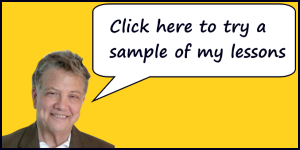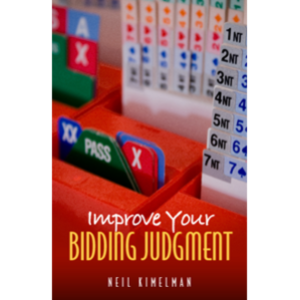How to Improve Your Results at Duplicate Bridge
Improve your duplicate scores and impress your partners.
An exciting and new audio-visual and interactive teaching method from Marty Bergen.
Marty's audio visual format significantly enhances your learning experience:
- The combination of voice and visual effects makes it easier to understand what Marty is teaching.
- The lesson is interactive, so students "learn by doing."
- You can proceed at your own pace.
- You can play and replay all or some of the lesson whenever you choose as many times as you like.
- The lesson includes a written easy to read transcript for you to study.
- The lesson contains several hours of extensive material.
- The lesson is designed to work on most popular computers and browsers, including Windows, Mac, and iPad.
Approximate running time of this lesson: 110 minutes.
Inescapable facts:
- Every player (and partnership) would like to do better than they presently do.
- Unless you and your partner declare and defend far better than "the field," the only possible way to significantly improve your results is to try to win the board in the auction. (Which could also be thought of as causing the opponents to lose the board in the auction.)
How can you win the board in the auction? By being super-aggressive competitively so that:
- Your opponents will not get to their correct contract. That includes striving to not allow them to get the contract at a low level.
- Your aggressive bid (or frisky lead-directing double) will enable your partner to make the best opening lead for your side. In addition, by immediately telling partner about your hand, that definitely will improve his bidding.
If instead, you compete only with obvious hands, your matchpoint score will be dependent on your pair's ability in card play. But since very few players consistently take more tricks than other players do, the result of that approach is likely to produce average results. And at the end of the game, once again you end up with a mediocre score.
In this lesson, Marty will show you how to:
- - Avoid playing "scared bridge".
- - Cause your partner to bid more accurately than he ever has
- - KNOW what is the #1 key to better competitive bidding
- - Ensure that partner makes the best lead for your side
- - KNOW which overcalls are the most effective
- - Make aggressive bids that are virtually risk-free
- - KNOW which bids are guaranteed to help your partner the most
- - Give your opponents an unsolvable problem
- - KNOW when being vulnerable can work to your advantage
- - Resolve whether "to bid or not to bid" with non-obvious hands
- - KNOW the right approach to handle very distributional hands
- - Become more knowledgeable about sacrifice do's and dont's
- - Compete with hands where other players will settle for an unhelpful pass
- - Push your opponents around, and cause them to be eager to leave your table!
Here is an example of what Marty will teach:
Your hand: ♠7 ♥107653 ♦AKJ106 ♣J3
Neither side vulnerable - You are in 3rd seat - The first two players pass - What would you do?
Answer to What Would You Do?
In 3rd seat not vulnerable, many players would open 1♥. It's okay to open light in 3rd seat, and everyone loves a 5-5 hand. But I believe that this is a very short-sighted bid.
4th seat rates to have the best hand at the table, and is likely to bid (very possibly spades). And if he becomes the declarer, your partner will be on lead. You are dying to get a diamond lead, but if you open 1♥, partner will lead your major. And even if you have a heart fit, the opponents are likely to have a spade fit and outbid you. So, if I decided to open at the one level, I'd bid 1♦.
However, this bid is also very imperfect. If you open 1♦, your partner will not rush to lead your minor suit. Also, 1♦ won't take much bidding space away from your LHO. In addition, although partner knows that you might open light in third seat, when you open at the one level, you could have a good hand. If partner has a decent hand with spades, the last thing you want to do is encourage him to compete in that suit.
How can you resolve all of these issues?
The answer is to open 2♦! Because this is the cheapest preempt, some players sneer at the preemptive value of this bid. I beg to differ. I have found a 2♦ opening to be extremely effective in causing my opponents to miss the boat, and am always eager to make this bid.
An exciting and new audio-visual and interactive teaching method from Marty Bergen.
Marty's audio visual format significantly enhances your learning experience:
- The combination of voice and visual effects makes it easier to understand what Marty is teaching.
- The lesson is interactive, so students "learn by doing."
- You can proceed at your own pace.
- You can play and replay all or some of the lesson whenever you choose as many times as you like.
- The lesson includes a written easy to read transcript for you to study.
- The lesson contains several hours of extensive material.
- The lesson is designed to work on most popular computers and browsers, including Windows, Mac, and iPad.
Approximate running time of this lesson: 110 minutes.
| Platform | Any browser |
|---|
An exciting and new audio-visual and interactive teaching method from Marty Bergen.
Marty's audio visual format significantly enhances your learning experience:
- The combination of voice and visual effects makes it easier to understand what Marty is teaching.
- The lesson is interactive, so students "learn by doing."
- You can proceed at your own pace.
- You can play and replay all or some of the lesson whenever you choose as many times as you like.
- The lesson includes a written easy to read transcript for you to study.
- The lesson contains several hours of extensive material.
- The lesson is designed to work on most popular computers and browsers, including Windows, Mac, and iPad.
Approximate running time of this lesson: 110 minutes.







